The latest goings on.
℘℘℘

BREXIT AND THE BORDER
The October 31 deadline is fast approaching and yet we seem to be as far as ever from agreeing on a deal for Brexit. The question of the Irish border continues to be a bone of contention between the Irish and British governments, and in recent weeks, Tánaiste Simon Coveney has described British proposals to solve the issue as “fanciful.”
In a speech that the second most senior person in the Irish government gave at a breakfast hosted by the Irish Consulate in New York, he expressed frustration that Ireland was spending “hundreds of millions” to prepare for Brexit, which he described as a “problem that is not of our making and that we disagree with.”
Tánaiste Coveney warned that border infrastructure would be inevitable if a hard Brexit resulted in two different regulatory systems on the island of Ireland. This would mean checks and controls at ports, airports and at certain points on the land border between both countries. While this would cause inevitable inconvenience to business and to regulatory bodies in both countries, the main worry is that the infrastructure itself would become a target for paramilitary groups that continue to exist, albeit in reduced numbers, in Northern Ireland and the border area.
Meanwhile, Taoiseach Leo Varadkar has said that there has been a distinct change of policy due to the change of prime minister. “Prime Minister May and her government were very much for a close relationship with the single market and a single customs territory…whereas the new prime minister and his government are looking for a looser arraignment, something more akin to the relationship the E.U. has with Canada. This actually makes the backstop all the more important and all the more necessary.”
℘℘℘

DUBLIN LOSING ITS CULTURAL CACHET
A number of recent closures of high-profile cultural venues in Dublin City has led to an outcry that the city is losing its cultural cachet and replacing it with high-cost accommodation and hotels.
Matters came to a head following the announcement that the Bernard Shaw pub was closing its Portobello location after 13 years. This pub – with its beer garden, food market, art, and performance spaces – was hugely popular and for many, it was the last straw.
The response from the public has led to a political move to safeguard Dublin’s cultural spaces. Dublin city councillors took a vote to protect cultural spaces and limit the number of hotels in the city. As they are the ones who control planning, this vote could have an impact in the future.
The Minister for the Arts Josepha Madigan has set up two late-night culture pilot schemes for both Dublin and Cork. These will look at the situation in detail and will also ask whether changing the country’s licensing laws could have a beneficial effect on Ireland’s nightlife.“We want to ensure that we protect our cultural spaces,” said Minister Madigan. “Artists are part of the fabric and DNA of being Irish, and we want to allow them to have the spaces to enjoy themselves and do something a bit different on a night out.” We want to ensure that we protect our cultural spaces,” she said.
℘℘℘
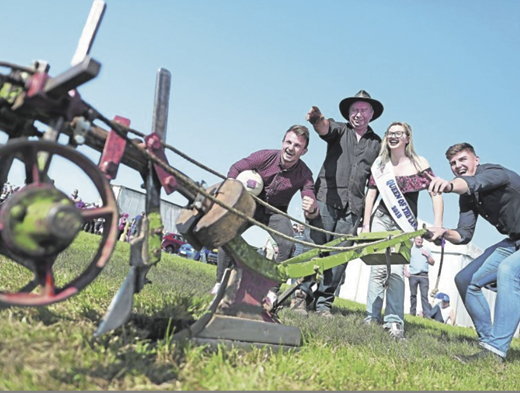
THE PLOUGHING STARS IN CARLOW
The National Ploughing Championships is one of Ireland’s most unusual and unique events. It takes place in a different location every year and this year, it was the turn of Fenagh in County Carlow.
From September 17-19, this small village was transformed into the beating heart of Irish agriculture. Over the course of the three days, a total of 297,000 people made their way to the grounds to see displays of livestock, machinery, crafts, live music, fashion, innovative technologies, over 1,700 exhibitors, and more than 300 competitors.
The event was officially opened on by President Michael D. Higgins, who used the opportunity to call for more support for Irish beef farmers in light of their recent protests about pricing. The focus of the event is always the ploughing competitions themselves. Former world champion Eamon Tracey from County Carlow won his tenth senior conventional plough title in a row and will shortly be competing for another world title in Russia.
Kilkenny’s Siobhán Darmody won the Farmerette (women’s) class and William Kehoe won gold in the Macra (or young farmer’s) category. This was the 88th year of the championships and every year sees record-breaking crowds. This looks set to continue, for the next generation are fans of this event too, as was obvious from the high number of entries in junior competitions.
℘℘℘

IRELAND’S YOUTH DELEGATES AT THE U.N.
Ireland’s U.N. Youth Delegates Valery Molay from Dublin and Jack O’Connor from Kilcolman, County Limerick, were selected to join Ireland’s official delegation to the United Nations for the U.N. General Assembly in New York in September. There, they had the opportunity to represent the youth of Ireland during sessions of the U.N. committee dealing with human rights issues.
Speaking ahead of their departure for New York, the delegates highlighted issues of importance to young people, who engaged with them on social media and sent video messages voicing their concerns in advance of the U.N. Climate Summit.
“This summer alone, we have seen the lungs of the earth on fire, extreme heat like never seen before across Europe, and strong hurricanes destroy millions of livelihoods. More importantly, a generation that has decided not to look the other way while our future goes out in flame has taken center stage. We may have contributed the least to this crisis, but if world leaders, corporations, industries, and individuals do not step up to the challenge, our entire generation will be condemned to a gloomy future,” they said in a joint statement.
℘℘℘
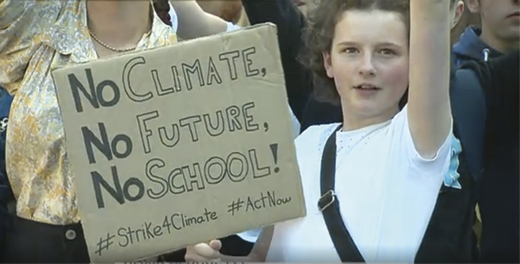
IRISH CHILDREN JOIN CLIMATE STRIKE
Thousands of Irish schoolchildren joined the Global Climate Strike, which took place on Friday, the September 20. There were more than 4,000 events registered worldwide for the international day of action and hundreds of schools across Dublin, Limerick, Cork, and Galway city centers got involved, as well as local communities in locations as scattered as Enniscorthy, Maynooth, and Dingle.
In Dublin, more than 10,000 children and young people gathered at the city’s Custom House Quay, where they held signs and chanted for over an hour. Despite Ireland becoming only the second country in the world to declare a climate emergency, the prevalent mood at these strikes was that the government was not doing enough to tackle the problem.
While their message was serious, their chosen means of communication was often humorous. Handmade signs included slogans such as “I’ve seen smarter cabinets in IKEA” and “Save the Sea, Michael D.”There was some controversy in the days before the strike when the prestigious fee-paying school Blackrock College barred its students from attending. Nevertheless, some Blackrock school uniforms were spotted in the crowds.
℘℘℘
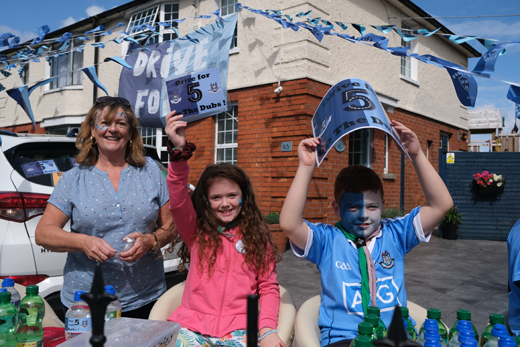
DUBLIN BEATS KERRY IN ALL-IRELAND
Old rivals Kerry and Dublin met in the All-Ireland Football Final again this year. Following a nail-biting draw on Sunday, September 1, which finished with both teams on 1-16 apiece, the teams took to the pitch of Croke Park for a replay on Saturday, the 14.
Dublin started in fine form and were 0-5 to 0-1 up after eight minutes. But Kerry rallied and the teams went into the second half with ten points each.
Everything changed in the first minute of the second half. Eoin Murchan scored a goal for Dublin. Although Kerry came back to within a point of the Dubs, they never managed to pull ahead. The older and more experienced Dublin team triumphed over Kerry manager Peter Keane’s young side and the game ended on a score of Dublin 1-18 to Kerry 0-15. Dublin made history. They are the first team in Gaelic Athletic Association history to ever have won five All-Ireland Football Finals in a row. Kerry tried and failed to do so in 1982, having won the previous four finals.
Dublin’s feat may never be repeated. Or they may go on to break their own record and make it six in a row next year. The rest of the country may have something to say about that, especially the Kerry team, who are young, quickly gaining in experience, and champing at the bit for a win.
℘℘℘

SMALL TOWNS BEAR THE BRUNT OF ASYLUM SEEKERS
Ireland’s latest economic boom passed by the small rural towns like Oughterard, County Galway; Moville, County Donegal; and Rooskey, County Roscommon, which have unwittingly generated international headlines after locals opposed centers designated by the Irish government to accommodate hundreds of asylum-seekers.
The town of Oranmore in County Galway has become a focal point in the protest. A public meeting that was organized in the town to discuss turning a closed hotel into an accommodation center for asylum seekers attracted a crowd of up to 700 people in early September and a few days later, hundreds marched through the town to protest. According to the 2011 census, Oranmore has a population of 4,799 people.
The main objection cited by locals was that it was too small to absorb an immigrant population of 300 asylum seekers. They also complained that they were not being properly consulted about the possibility of having an asylum center located in their town.
Politicians have rowed into the debate. Local Independent TD Noel Grealish was recorded speaking at the initial meeting, calling the asylum seekers “economic migrants from Africa who were coming to Ireland to sponge off the system.” His remarks prompted widespread criticism, with Taoiseach Leo Varadkar urging him to withdraw them.
President Michael D. Higgins has spoken out too, appealing to both sides. Speaking on a visit to New York, he said: “People are entitled, as citizens going through processes of change, to be communicated with and given the best possible information.”
However, he added that there had been “sinister anti-migrant” messages put out and that people needed to discuss migration armed “straightforwardly with facts.”
“When you look at the evidence that is sometimes fired around, have migrants replaced workers,” he asked. “The empirical evidence is that they have not. Then look at whether migrants replaced people on housing lists. They have not. We must correct facts when they’re abused in this way.”
Meanwhile in Galway, GAA stars ran along asylum seekers in an 8K race to show their support for those living in Direct Provision. The race took place on August 10 with race-walking world champion and Olympic medalist Olive Loughnane and All-Ireland winner Alan Kerins joining the Sanctuary Runners.
℘℘℘
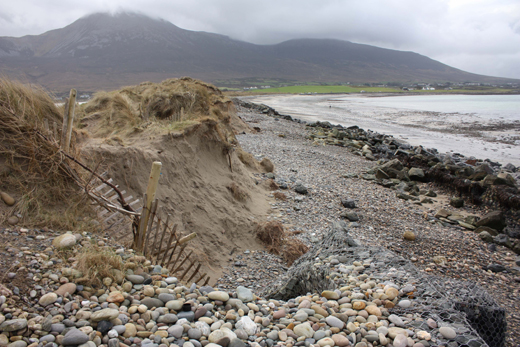
THE FUTURE OF BERTRA STRAND
NUI Galway’s School of Geography and Archaeology hosted an event on September 26 to kickstart local climate action that threatens the long-term future of Bertra Strand in County Mayo.
Located on the southern shore of Clew Bay, Bertra Strand and its dunes are in a precarious state. It has been pounded by a series of storms in the past decade with dire consequences. These and other pressures, especially climate change, threaten its long-term future. An integrated vision is needed for the future welfare of the whole coastal landscape, where the natural environment is inextricably linked to that of the local communities of Murrisk, Lecanvy, and Belclare.
Ongoing coastal erosion and flooding, a perceived lack of integration in planning and management to-date, and local jobs into the future are issues that have been identified in the area. Dr. Kevin Lynch, School of Geography at NUI Galway, says: “We must capitalize now, on the surging political consciousness of climate-related threats that coastal communities have been highlighting for years. Locally led actions supported by responsible authorities can drive real change, if citizens act now.”
Professor Enzo Pranzini (University of Florence), Professor Bas Pedroli (Wageningen University), and Dr. Maura Farrell (NUI Galway), shared experiences at a follow-up event by the E.U. AELCLIC Project at The Tavern, Murrisk, County Mayo, on October 1. The outcomes of the events are expected to be a greater awareness of possible solutions and a solid commitment from those interested to work together to take action. ♦

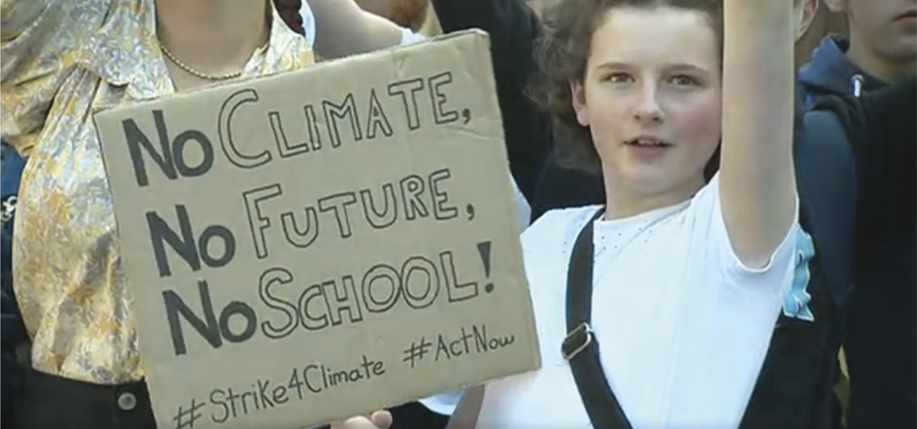
Leave a Reply